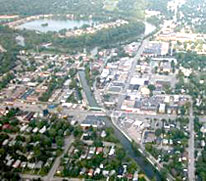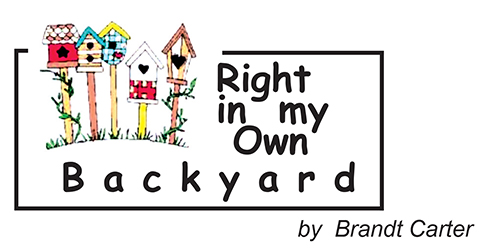
|
Broad Ripple Random Ripplings

The news from Broad Ripple
Brought to you by The Broad Ripple Gazette
(Delivering the news since 2004, every two weeks)

|
| Brought to you by: |

|

|

|

|

|

|
Converted from paper version of the Broad Ripple Gazette (v11n21)
Right in my Own Backyard - One of Autumn's Delights - by Brandt Carter
posted: Oct. 17, 2014

One of Autumn's Delights
What is the most plentiful nut in many backyards? It's brown, appears in the fall, and has a cap. It's not one we usually eat but is so common that squirrels often pass them by to raid our feeders. You've probably guessed the answer by now-an acorn.
Plentiful acorns from the mighty oak influence our lives whether we are aware of them or not. Haven't you heard "An acorn doesn't fall far from the oak tree" as the familiar expression associating child-parent similarities? Acorns are featured in many fall decorations and find their way into holiday celebrations.
Some people even think acorns, like persimmon seeds, can predict the severity of an approaching winter. My research has not been able to confirm this to be true. Abundance of acorns does not forecast weather. In fact, because it takes some time for oaks to bear these nuts, the quantity of acorns is primarily a result of previous spring and summer weather conditions. Oaks are wind pollinated, which means favorable conditions in the spring determine acorn volume. Some oaks produce acorns every two years thus, the spring two years earlier would affect the crop. Severe winters can be a factor as well.
Whether the acorn crop is heavy or light, it is important to the ecology of our urban setting. Squirrels, blue jays, some woodpeckers, and ducks eat acorns. Field mice and other rodents add these freebies to their winter caches. Even deer will use this high energy nut as alternative food. Did you know whitetail deer like acorns from all the different types of oak trees but their favorite is white oak acorns? Squirrels and jays will carry off acorns and bury them. Some are unearthed later and some are forgotten. Lucky for hidden acorns, they sprout and grow as trees. This is the main reason I mow the lawn. If my husband were in charge, every oak seedling would be growing, and we would not be able to see out our windows.
Some trivia about acorns:
- Acorns are one of the few nuts not named for their tree; thus, no oak nuts.
- The crop of acorns is called a mast.
- If you find acorns on the ground without caps, they may be infested. If the acorn is heavy enough to pull itself from its cap this usually means there is a worm moving around in the nut.
- Acorns can be eaten (I am not game!), but they should be leached. Raw acorns are bitter and can be toxic in large quantities. They can be roasted, sautéed, or ground into flour. Indians included them in their diets.
- Dyes can be made from boiled acorns, yielding a tannic water.
- Squirrels like the top or whiter part of the acorn. It is less bitter. Burying the darker and lower parts of the acorn decreases bitterness over time.
The shape of acorns has always fascinated me. Gathering nuts from different kinds of oak trees has contributed to my craft projects. From using acorns in arrangements to making little doll head out of them, this nut is a great addition to artisan projects. Just Google "acorn crafts" for ideas galore. Even Martha Stewart has creative suggestions for low-budget decorations with acorns. I'm collecting them again this fall and will see what I can make when I have to hole up this winter.
Next time you go for a walk, take a bag, and gather some acorns. See if you can identify the kind of oak by it acorn. Gather enough to try a project. Celebrate the fall gifts of nature.
Brandt Carter, artist, herbalist, and naturalist, owns Backyard Birds at 2374 E. 54th Street. Visit her web site www.feedbackyardbirds.com. Email your bird questions to Brandt@BroadRippleGazette.com
brandt@broadripplegazette.com

|

|

|
| Brought to you by: |

|

|

|
| Brought to you by: |

|

|

|
| Brought to you by: |

|

|

|
| Brought to you by: |


